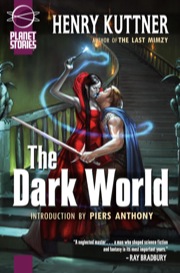| John Warren |
This may help to clarify:
People from a comic book background are accustomed to the term "trade paperback" being used to refer to a collection of previously published comics, like Flaming Man #21-28.
However, the term is also used in "regular" book publishing for books that are of larger dimensions than a normal mass market paperback.
So, to be 100% clear... this is a prose novel, not a comic book or graphic novel.
Hope that helps!
| Theris Nordo Ichka |
I subscribed recently and just yesterday received my first book, “The Dark World”, and can’t wait to start it.
But first, I’ve got a few book ideas for you:
“Space Hawk” by Anthony Gilmore
I’ve recently read “Space Vulture” (a modern tribute to pulp sci-fi) by Gary K. Wolf (creator of Roger Rabbit) and Archbishop John J. Myers. In the introduction to it they speak fondly of “Space Hawk”, it was “Space Hawk” that started them on sci-fi and inspired them to write.
I haven’t read “Space Hawk”, so I can’t recommend it personally, but I think it’s worth looking into. I’ve searched for it on Amazon but the only copies available are old, used, and expensive. As far as I can tell, it hasn’t been in print for at least fifty years.
If you were to publish it, I’m sure you could easily get Gary K. Wolf or John J. Myers (or both) to write an introduction.
“The Goddess of Atvatabar” by William R. Bradshaw
“Goddess of Atvatabar” is an early hollow-earth adventure, preceding ERB’s Pellucidar series by several years at least.
Sadly, another book I haven’t read. But I’ve heard it’s good and I’d like to read it (though I’d rather read it in a new Planet Stories edition than in an old falling-apart antique). I believe it’s also out of print.
“The Wizard of Venus” by Edgar Rice Burroughs
It’s a novelette, so you’d have to include other material---how about “Elmer”, the ERB story that was edited into being “The Resurrection of Jimber-Jaw”. (“Elmer” has not seen print since 2001, in a limited edition anthology)---to fill out the book. You could almost recreate the old “Tales of Three Planets” collection.
“Wizard of Venus” is the only story from any of ERB’s more famous series’ that is not being published by Leonaur.
I’d love it if you published any of the above, particularly “Space Hawk”.
Hope to hear from you soon,
---Theris
 Vic Wertz
Chief Technical Officer
Vic Wertz
Chief Technical Officer
|
But first, I’ve got a few book ideas for you:
You might want to drop those in the Planet Stories Requests thread.
| Theris Nordo Ichka |
Theris Nordo Ichka wrote:But first, I’ve got a few book ideas for you:You might want to drop those in the Planet Stories Requests thread.
Thanks.
| Kata. the ..... |
This was an astounding book, but I have one complaint. I mostly read on the bus in Tempe on the way to work and the way back (about an hour a day). I started this book on Tuesday and I will need to bring something else to read for the return trip Monday which could be a problem because Death in Delhi is not even listed as pending yet.
Other than that, this book is great. The Reavers of Skaith is anxiously awaited here, although I get the impression that might be the last of Skaith we see.
| Kirth Gersen |
People who liked this novella will certainly want to find a copy of Abraham Merritt's Dwellers in the Mirage -- a much longer work with an almost identical plot, written 14 years before The Dark World was published. In my opinion, Merritt's work is infinitely superior in terms of "cool" ideas, and also in terms of action and story. (I suspect that, if not for its influence on Roger Zelazny's early "Amber" series, The Dark World would remain forgotten in the shadow of its predecessor.)







